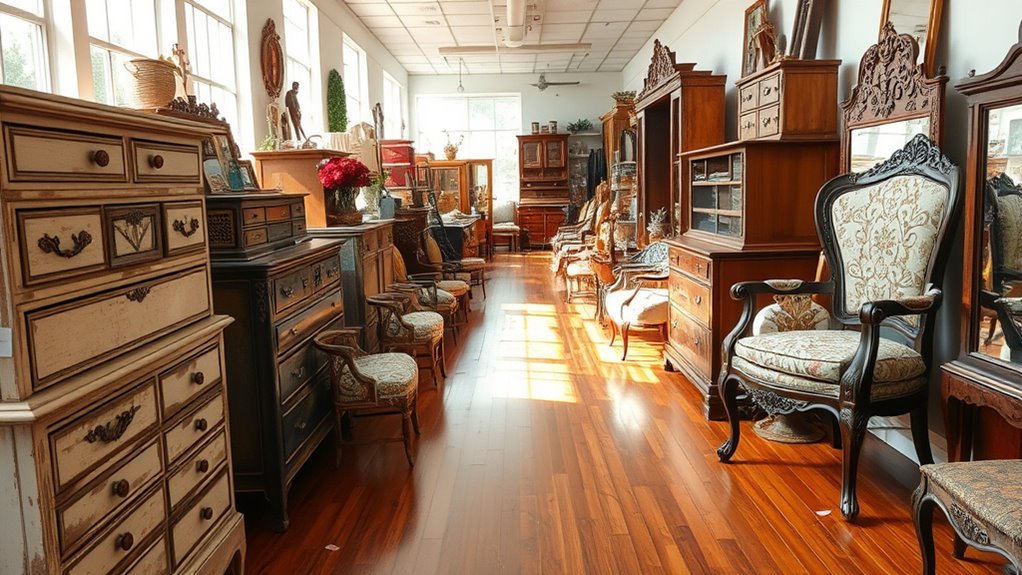When thrift shopping for furniture, look for pieces with sturdy construction, interesting details, and classic styles that show craftsmanship. Check for wobbling legs, loose joints, or any signs of damage or wood rot. Visualize how you might restore or customize items to fit your space. Be patient and visit multiple stores or markets to find unique, quality pieces that support sustainability and your budget. Keep exploring to discover more tips for successful thrift furniture hunts.
Key Takeaways
- Examine structural elements for stability, checking joints, legs, and wood condition.
- Look for unique details, craftsmanship, and vintage charm that indicate quality.
- Inspect finishes for scratches, chips, or fading, and consider repair options like sanding or repainting.
- Visualize potential transformations and consider how the piece can be customized or restored.
- Explore multiple sources, including thrift stores and online marketplaces, with patience and persistence.

Ever wonder how you can find stylish, affordable furniture while giving items a second life? Thrift shopping is a fantastic way to do just that. By exploring thrift stores, flea markets, and online marketplaces, you can uncover unique pieces that reflect vintage styles and add character to your space. The key is knowing what to look for and how to spot quality furniture that’s worth restoring or keeping as-is. When hunting for vintage styles, keep an eye out for items that showcase classic lines, interesting details, or distinctive finishes. These pieces often have a charm that new furniture can’t match, and with a little furniture restoration, they can become the centerpiece of your room.
Start by inspecting the furniture thoroughly for structural integrity. Check for loose joints, wobbling legs, or any signs of wood damage, such as cracks or rot. If you’re comfortable with DIY projects, these issues can often be fixed with simple repairs, making thrift shopping a budget-friendly option for acquiring high-quality furniture. Don’t forget to examine the finish—look for scratches, chips, or fading, which can be easily addressed through furniture restoration techniques like sanding, repainting, or re-staining. This process not only revitalizes the piece but also allows you to customize it to your style, blending vintage charm with modern aesthetics.
Inspect thoroughly for loose joints, damage, and finish issues to ensure quality and ease of restoration.
When browsing, consider the story behind each piece. Vintage furniture often carries a sense of history and craftsmanship that’s hard to find in mass-produced items. You might come across a sturdy wooden dresser with intricate carvings or a retro armchair with a bold fabric pattern. These pieces can be transformed into statement furniture with a little effort, giving you a one-of-a-kind item that’s both eco-friendly and budget-conscious. Remember, the secret to successful thrift shopping for furniture is patience and persistence. It might take several visits or online searches to find that perfect piece, but once you do, you’ll have something special and sustainable to enjoy.
In addition to the aesthetic value, buying vintage styles through thrift shopping supports sustainable living. Instead of buying new, you’re extending the life of existing furniture, reducing waste, and lessening environmental impact. With a bit of furniture restoration, you turn a forgotten relic into a cherished piece. So, embrace the hunt, learn some basic repair skills, and enjoy the thrill of discovering timeless, quality furniture that fits your budget and style. Your home will thank you for it.
Frequently Asked Questions
How Do I Assess the Durability of Thrifted Furniture?
To assess the durability of thrifted furniture, you check the material longevity and structural integrity. Look for solid wood and avoid particleboard or pressed wood, which tend to break down faster. Test the furniture by gently applying pressure to see if it wobbles or creaks. Examine joints and hardware for sturdiness, and inspect for cracks or signs of damage. This way, you guarantee your thrifted find will last.
What Are the Best Days to Find New Items in Thrift Stores?
Wondering when to score the best finds? The best shopping days are typically right after new item arrivals, often early in the week or during special restock days. Thrift stores tend to refresh their inventory then, revealing hidden gems. Keep an eye out for weekly sales or special events too. By shopping on these days, you increase your chances of snagging unique, quality pieces before others even arrive.
How Can I Tell if Furniture Is Worth Restoring?
You can tell if furniture is worth restoring by checking its upholstery fabric for tears, stains, or odors, which may be costly to fix. Examine the wood craftsmanship for sturdy joints, minimal scratches, and no signs of rot or insect damage. If the frame feels solid and the upholstery is salvageable, it’s likely worth restoring. Focus on quality materials and craftsmanship to guarantee your effort results in a beautiful, durable piece.
Are There Specific Styles That Tend to Be More Affordable?
Did you know vintage styles are often more affordable? You’ll find that mid-century modern pieces tend to be budget-friendly because they’re highly popular, making them easier to find at thrift stores. Vintage styles also have timeless appeal, so you get great value. Keep an eye out for authentic mid-century modern furniture, and you might score quality pieces without breaking the bank, perfect for your home makeover.
How Do I Clean and Sanitize Thrifted Furniture Properly?
To clean and sanitize thrifted furniture properly, start with thorough cleaning techniques like vacuuming or sweeping to remove dust and debris. Use a mixture of mild soap and water for surfaces, and for upholstery, consider a fabric-safe cleaner. For sanitization, apply disinfectant sprays or wipes that contain at least 70% alcohol, making sure to follow the product instructions. Always allow surfaces to dry completely before use to guarantee safety and cleanliness.
Conclusion
So, next time you score that quirky, slightly chipped chair at a thrift store, remember—you’ve just scored a piece with a story, character, and maybe even a little history. Who knew that hunting for quality furniture could be so rewarding (and a bit of a treasure hunt)? Embrace the imperfections, because sometimes the best finds are the ones with a little wear and tear. Happy thrifting—your perfect, one-of-a-kind piece is just a trip away!









